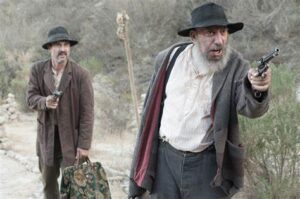
If The Hills Have Eyes and Cannibal Holocaust were to have a baby in the Wild West, the result might be Bone Tomahawk, a tense and engaging pursuit Western that devolves into a blood bath. The first few minutes of the film feel like a fairly standard Western, despite the horrific opening sequence involving a throat being slashed and a hideous, demon-like figure seen from a distance.
In pursuit of the mutated tribesmen are Sheriff Franklin Hunt (Kurt Russell), his backup deputy Chicory (Richard Jenkins), the drifter/gunslinger John Brooder (Matthew Fox), and the injured foreman Arthur O’Dwyer (Patrick Wilson). While Zahler holds back the identities of the cannibals the men are looking for, the audience tags along for the ride, increasing their level of fear and shock when Sheriff Hunt and Chicory are captured and witness the savages’ horrific methods of punishment. Bone Tomahawk is a genre-bending affair with a horror premise that incorporates mystery, action/adventure, and the Western tradition. It also borrows heavily from Italian cannibal films, a subgenre known for its graphic depictions of violence and death. The over two-hour script by Zahler sets up the stakes and motivations of the characters before unleashing a barrage of violence in the third and final act.
A sick family tree of inbred monsters who eat their mothers and are raised by other inbred monsters, called “Troglodytes,” have abducted and murdered several town residents. We can anticipate that the Sheriff and the citizens of the town will run into these beasts on their way to free the captives. And most films would be happy to wink and play with that irony as they set up these jaded cowboys for their inevitable encounter with the unbelievable.


The sophistication of Bone Tomahawk is maintained even when the film delves into the cult-movie territory. Zahler is a patient director who lets scenes develop naturally, allowing for tense moments to emerge.
As the men’s plight grows direr, the camera moves in for a closer look. There isn’t even any of the wild stylistic hysteria that sometimes takes over genre-bending movies in the climax. That the director’s unflinching eye reveals both character and violence is, perhaps, what makes it so unsettling. True, Bone Tomahawk is frightful and bizarre, but its beauty lies in its period veneer.
As they travel across the plains, a spooky score plays in the background. As the four men get closer and closer to the troglodytes’ cave, the eeriness of the score raises tensions and brings you to the brink of breaking. Bone Tomahawk also makes use of other forms of aural design to achieve its mood. Animalistic to the point of having blow holes made of bone implanted in their throats, the cannibal tribe is portrayed here. It gives you the chills every time you hear those sadistic sirens. Every time this happens, a brutal massacre ensues. The plains are home to these troglodytes, who make their living as butchers.
As the plot develops, we learn more about the characters and begin to believe that they have a shot at achieving their objective. They don’t realize how completely outmatched they are until they face off against the enemy for the first time. The troglodytes can blend in with their rocky surroundings thanks to their skillful use of body paint. Their weapons are crude but devastatingly effective. Their bows and arrows are effective at long range, but their hand weapons are what set them apart. The film’s title comes from the fact that the protagonists wield bone-handled war hatchets. They’re viciously calculated in their assaults. Even though they eat their own kind, this cannibalistic tribe is quite sophisticated and deadly in its own right.
For the final time, Zahler breaks our hearts in the scene just before Sheriff Hunt and Chicory say their goodbyes. The actors and Zahler display a lot of dignity when the sheriff tells his loyal deputy, “You say hello to my wife and I’ll say hello to yours.” The two men turn a goodbye that could have been simplified into the perfect summation of their relationship. That they will continue to watch out for each other even in death. I can’t praise Zahler enough for imbuing the entire film with such understated moments of brilliance.

